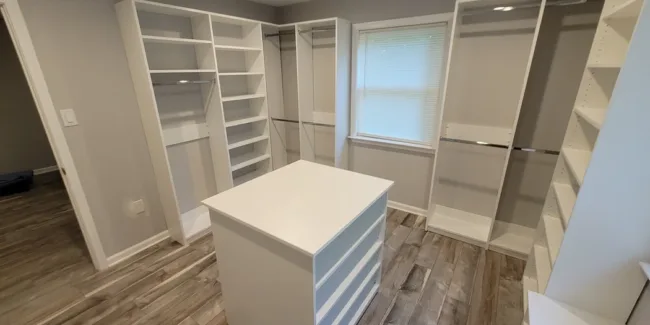
Your cluttered home doesn’t need a complete overhaul; it needs a strategic transformation. Living in a clutter-free environment has demonstrated psychological benefits. Research suggests that tidy homes lead to improved focus and lower stress levels.
Today’s minimal home design isn’t about stark, empty rooms that feel cold and unwelcoming. Instead, it’s about creating purposeful spaces where every piece serves multiple functions while maintaining that clean, serene aesthetic we all crave.
Core Principles of Functional Home Decor in Minimalist Spaces
The foundation of successful functional home decor starts with understanding that less truly can be more when done thoughtfully. These principles will guide your transformation from chaotic to calm.
This modern approach strips away the unnecessary while emphasizing purposeful design elements that serve daily needs without cluttering the space. Storage plays a pivotal role in achieving this balance, and that’s where My Closet Guys stands out. Their custom-built solutions offer sleek, space-saving designs that seamlessly integrate into minimalist interiors, transforming everyday organization into a refined visual experience.
With a focus on clean lines and personalized craftsmanship, they help homeowners create spaces that are both beautiful and effortlessly functional.
The 80/20 Rule for Minimalist Interior Design
Minimalist interior design follows a simple principle: 80% of your space should remain uncluttered, while 20% can showcase carefully chosen functional items. This doesn’t mean you can’t have personal belongings; it means being selective about what stays visible.
Consider your living room coffee table. Instead of covering it with magazines, remotes, and decorative objects, choose one beautiful book and perhaps a small plant. The remaining space allows your eye to rest and the room to breathe.
Multi-Purpose Furniture Selection Strategies
Every piece in your home should earn its place by serving multiple functions. Ottoman storage cubes provide seating, footrests, and hidden storage. Dining tables with built-in drawers eliminate the need for separate storage furniture. Wall-mounted desks fold away when not needed, maintaining clean lines while providing workspace.
Color Psychology in Modern Minimalism
Modern minimalism embraces warm neutrals over stark whites. Soft beiges, gentle grays, and cream tones create inviting atmospheres while maintaining that clean aesthetic. These colors reflect natural light beautifully, making spaces feel larger and more welcoming.
Now that you understand minimalism’s transformative potential, let’s explore the foundational strategies that make functional minimalism actually work in real homes.
Room-by-Room Implementation of Blending Styles in Home Decor
Blending styles in home decor requires understanding each room’s unique needs while maintaining overall cohesion. Each space demands its own approach to balancing function with minimalist principles.
Kitchen Minimalism with Maximum Storage Efficiency
Your kitchen can’t sacrifice functionality for aesthetics. Focus on hidden storage solutions—deep drawers instead of cabinets, built-in spice racks, and appliance garages that keep countertops clear. Choose one or two statement pieces, like a beautiful cutting board or ceramic canisters, as your 20% display items.
Living Room Balance: Comfort Meets Clean Lines
Create conversation areas with fewer, better pieces. One substantial sofa beats multiple small chairs that crowd the space. Add texture through throw pillows and blankets, but limit colors to your chosen palette. Storage ottomans and console tables with drawers maintain a clean aesthetic while hiding everyday items.
Bedroom Sanctuaries: Rest-Focused Minimalist Design
Bedrooms should promote rest and calm. Keep surfaces clear except for essentials like a lamp and perhaps one book. Built-in nightstands eliminate visual clutter while providing necessary storage. Choose quality bedding in neutral tones that invite relaxation.
Bathroom Zen: Spa-Like Functionality with Storage Solutions
Transform bathrooms into spa-like retreats with hidden storage for toiletries and medications. Wall-mounted vanities create visual space while providing storage underneath. Keep countertops clear except for daily essentials in beautiful dispensers.
With these core principles as your guide, it’s time to see how the 80/20 rule and multi-purpose thinking translate into specific spaces where you live, cook, and rest daily.
Smart Storage Solutions That Maintain Minimalist Aesthetics
While each room benefits from tailored minimalist approaches, the secret to maintaining these clean aesthetics lies in storage solutions that work behind the scenes.
Hidden Storage Integration Techniques
Built-in storage that appears seamless with your walls creates the illusion of more space. Floor-to-ceiling cabinets painted the same color as the walls disappear visually while providing massive storage capacity. Under-stair storage and window seat storage maximize every square foot.
Vertical Space Optimization Without Visual Clutter
Think upward when floor space is limited. Floating shelves display beautiful items while keeping floors clear. Wall-mounted hooks and magnetic strips keep frequently used items accessible but organized. Tall, narrow storage units draw the eye upward, making rooms feel taller.
Closet Organization Systems That Blend Seamlessly
Well-designed closet systems prevent bedroom clutter by giving everything a designated place. Uniform hangers, coordinated storage boxes, and efficient layouts make getting dressed easier while maintaining minimalist principles in visible spaces.
Beyond physical storage, modern minimalist homes leverage technology to eliminate visual clutter while enhancing functionality through smart, nearly invisible solutions.
Technology Integration in Modern Minimalist Homes
As we step into 2024, we are bidding farewell to the recently popular ultra-minimalist look. Homeowners are now drawn to spaces that embody depth and dimension, instilling a unique sense of individuality and warmth. This shift includes how we integrate technology seamlessly.
Smart Home Devices That Disappear Into Design
Modern smart speakers blend into decor when chosen in neutral colors. Smart thermostats with clean displays complement minimalist walls. Voice-controlled lighting eliminates the need for multiple switches and control panels, maintaining clean wall surfaces.
Wireless Solutions for Cable-Free Living
Eliminate visual clutter by going wireless wherever possible. Wireless charging stations built into furniture, Bluetooth speakers, and wireless security cameras maintain clean lines. When cords are necessary, use cable management systems to hide them completely.
Digital Minimalism: Reducing Electronic Clutter
Consolidate entertainment systems into single units. Stream content instead of collecting DVDs. Use tablets instead of multiple magazines and books. Digital photo frames rotate family pictures without requiring wall space for multiple frames.
As your home becomes smarter and more streamlined, the next evolution involves choosing materials and systems that support both your minimalist goals and environmental values.
Sustainable Minimalism: Eco-Friendly Functional Choices
While sustainable minimalism offers long-term benefits, many homeowners wonder how to achieve this transformation without breaking the bank. Here’s how sustainability and minimalism complement each other perfectly.
Sustainable Materials That Enhance Minimalist Aesthetics
Natural materials like bamboo, reclaimed wood, and natural stone provide texture and warmth while supporting environmental goals. These materials age beautifully, developing character over time rather than looking worn. Cork flooring, hemp textiles, and recycled glass accessories maintain clean aesthetics while reducing environmental impact.
Energy-Efficient Lighting for Clean Design
The LED lighting solutions provide clean lines while reducing energy consumption. Under-cabinet LED strips illuminate workspaces without visible fixtures. Smart lighting systems adjust throughout the day, supporting both energy efficiency and the clean aesthetic of minimalist spaces.
Zero-Waste Minimalist Living Strategies
Choose quality items that last rather than trendy pieces requiring frequent replacement. Repair rather than replace when possible. Compost systems can be beautifully integrated into kitchen designs. Glass storage containers eliminate plastic while looking clean and organized.
Even with budget-conscious strategies in place, many well-intentioned minimalist transformations fail due to predictable pitfalls that compromise both function and style.
Common Mistakes to Avoid in Minimalist Home Design
Learning from these common missteps positions you to create minimalist spaces that not only work beautifully today but also adapt seamlessly as your life evolves.
Over-Decluttering: When Less Becomes Impractical
Don’t eliminate items you need. Keep cooking utensils if you cook regularly. Maintain adequate seating for your family size. The goal is intentional living, not deprivation. Sometimes you need that extra throw blanket or additional storage basket.
Neglecting Personal Style for Trends
Your home should reflect your personality, not magazine perfection. Include meaningful artwork, family photos, or collections that bring joy. The key is displaying these items thoughtfully rather than cramming them everywhere.
Functionality Compromises That Backfire
Never sacrifice essential functions for aesthetics. If you need a home office, create one—don’t try to work from your dining table permanently. Children need toy storage that’s accessible. Pets need their own spaces and supplies.
Armed with strategies for long-term minimalist success, let’s address the most pressing questions homeowners have about making functional minimalism work in their unique situations.
Your Minimalism Questions Answered
- Can minimalist homes accommodate families with children?
Absolutely. Focus on smart storage solutions, washable surfaces, and designated play areas. Teach children organizational habits early while maintaining child-friendly functionality throughout your home.
- How do I maintain minimalism without feeling cold?
Incorporate natural textures like wool rugs, linen curtains, and wood accents. Use warm lighting and add plants. Minimalism should feel calm and welcoming, not stark or uncomfortable.
- What’s the difference between cheap and investment minimalist pieces?
Quality pieces serve multiple functions, last longer, and maintain their appearance. Invest in foundational items like sofas and storage systems. You can save on accessories and easily replaceable items.
